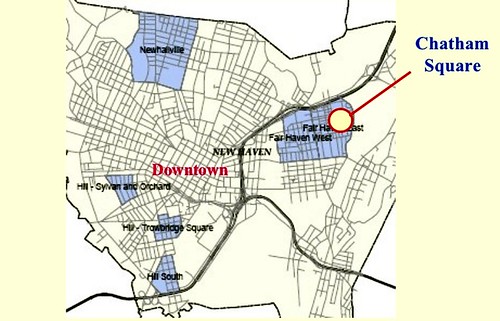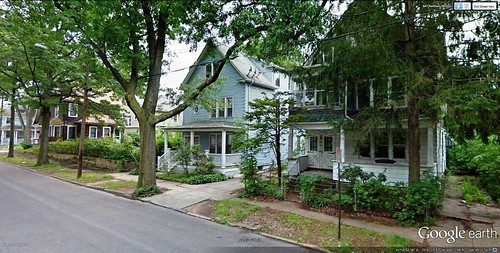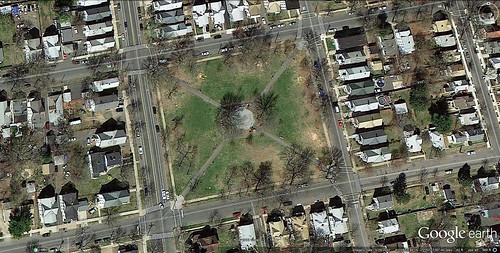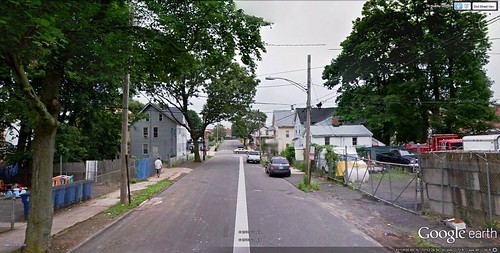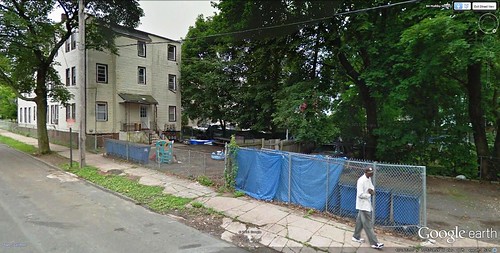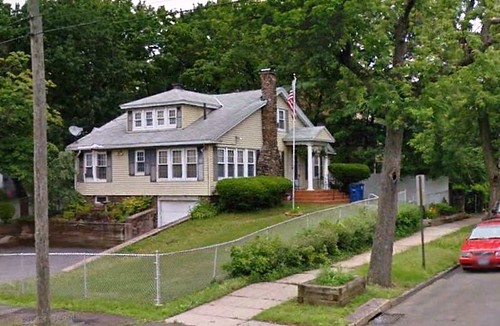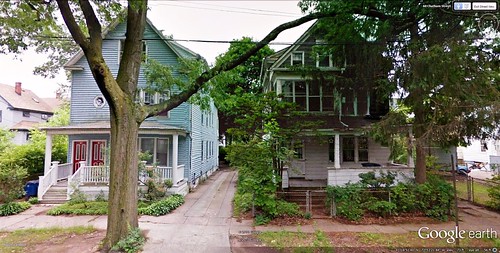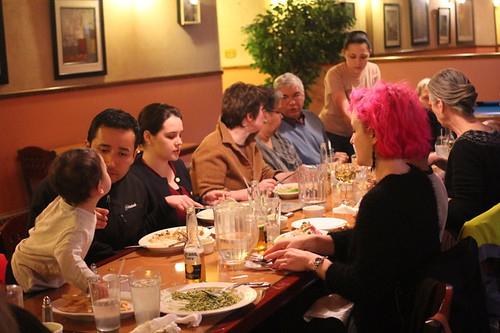How a once-disinvested neighborhood is building community with pride and leadership (written with Matt Higbee)

Posted August 1, 2013 at 1:26PM
The Chatham Square area of New Haven reminds me of the first neighborhood that I grew up in (minus the hills we had in Asheville): wood-frame, working-class houses, with some duplexes, on tree-lined streets. Modest, yet architecturally sturdy and proud. My old neighborhood has seen its ups and downs since back in the day, and so has Chatham Square.
The Square sits in New Haven’s Fair Haven district, east of downtown and just west of the Quinnipiac River. Fair Haven’s population peaked at near 24,000 in the 1930s but, like so many inner-city neighborhoods, had declined 40 percent to under 14,000 by 2000. More specifically in Chatham Square, today there are around 3,500 residents comprising 1,100 households. 42 percent of the population is Hispanic and the median household income is low, at around $33,000 annually. (According to the US Census, the three-year average median income for Massachusetts, using 2009-2011 data, was $62,809.) The housing stock around Chatham Square, mostly two- and three-family structures, is a mixture of well-tended and significantly declined or abandoned. Some infrastructure needs repair.
According to Walk Score, “Fair Haven is the 5th most walkable neighborhood in New Haven with a neighborhood Walk Score of 77.” (The Walk Score taken from Chatham Square proper is 69.) There are bus routes all over and a commercial street, Grand Avenue (recently traffic-calmed, according to a report), on the southern edge of the district. The river is only a couple of blocks from the neighborhood’s center. If you believe in urban sustainability, this is the kind of neighborhood you want to succeed.
Chatham Square itself, for which the neighborhood is named, is a bucolic city park, if perhaps also a bit worn. Looking at photos from Google Earth of nearby streets, some shown with this article, one senses that this is a neighborhood that could go either way, into further decline or, like some reviving districts in other cities with good leadership, into a new age of rebirth.
But take a look at the composite photo at the top of this article. Fortunately, the outcome is no longer in doubt. With a fantastic home-grown spirit, this neighborhood is doing everything right. Once-sketchy Chatham Square Park is now safe, and home to several annual neighborhood festivals that draw visitors from around the city and beyond; home values have stopped declining; and there is an almost tangible sense of pride in the community’s diversity.
An announcement of a “Rediscovering Chatham Square” walking tour, held earlier this summer and co-sponsored by the New Haven International Festival of Arts and Ideas and the New Haven Preservation Trust summarized how the neighborhood is becoming a showcase:
“This tour focuses on the history and stories of transformation of northeastern Fair Haven. See and hear how residents and local business owners, working with the City of New Haven and community agencies, changed the neighborhood's image, physical condition, and market. Also learn how problems are managed in this beautiful and historic waterfront neighborhood.”
Much of the credit belongs to the Chatham Square Neighborhood Association, which has become a catalyst for community engagement, and to the behind-the-scenes support of the Community Foundation for Greater New Haven. Indeed, Chatham Square leaders are now working with other neighborhoods to help spread their success.
The situation a decade ago
This is a remarkable turnaround. A decade ago, things were shaky in the neighborhood. The real estate boom of the early 2000s that was lifting property values and stimulating the economy across the country was bypassing Chatham Square. Mired in a decades-long decline, the area suffered from low rates of home ownership and a general sense that the area was unsafe. As houses became available, they were being scooped up by less-than-reputable absentee landlords rather than resident homeowners. And the park at the neighborhood’s heart, which should have been a natural place for neighbors to gather, went unused, with drug dealers and prostitutes more likely to be its inhabitants than families and children.
Despite these issues, a handful of dedicated residents believed in their neighborhood and saw its potential. Architecturally distinctive houses lined shady streets. There was a marina at the edge of the neighborhood and park along the Quinnipiac River, where Native Americans once harvested oysters and the first European settlers built and docked ships. And they had the “City Beautiful”-era Chatham Square Park, which they were trying to keep clean and safe through organized cleanups and gardening days. But the same people were doing all the work, and they were struggling to make a big enough difference.
Stepping into this environment under the umbrella of its urban neighborhood strategies initiative, The Community Foundation for Greater New Haven began to engage neighborhood residents. The Foundation already had a long history of community involvement, providing leadership training and funding to groups in the city and Greater Naugatuck Valley for such local projects as beautification, community gardens, youth and elder enrichment, summer schools and afterschool programs.
In Chatham Square, the Foundation began to ask residents for their visions and needs, identifying and cultivating leaders who could make lasting change possible. “They were fighting an uphill battle,” says Lee Cruz, the community outreach director for the Community Foundation for Greater New Haven. “Individuals were working hard but they were uneven efforts because they were disconnected.”
Community conversations
Several leaders were already known to the Foundation through their participation in the Community Gardens and Community Greenspaces program - a nearly two-decades-long collaboration of the Foundation with the New Haven Land Trust, the New Haven Urban Resources Initiative, and the city’s Livable Cities Initiative. A door-knocking campaign brought in other residents who wanted to see change and were willing to work for it.
With this core group, the Foundation convened a series of conversations about the neighborhood to better understand their most pressing concerns and how the Foundation could best work with them. Behind this approach was the principle of building a relational culture, recognizing that the power of a community comes from people coming together to listen to each other without judgment, and to work collectively toward identifying problems and addressing issues of collective concern. By contrast, a top-down approach could risk creating well-intended programs that nevertheless fail to address the priorities of the people who are most affected.
The Foundation helped guide this conversation using the Healthy Neighborhood framework, developed by Fall Creek Consultants. According to staff for the Foundation, the HNF is a strategy that empowers residents to be a positive influence on the market for their neighborhood: the framework posits that, just as a person’s healthy life depends on the four elements of nutritious food, sleep, a stable home and nurturing relationships, a neighborhood’s health also depends on four critical factors: image; the real estate market; physical condition; and management of quality-of-life issues. Go to the linked website for a full and very rich description of the framework and its application in Chatham Square.
Putting magic marker to sheets of butcher-block paper, neighbors brainstormed their top issues in each category. Over several months, ideas coalesced into plans. The Foundation committed to an $80,000 grant to seed activities that would support the neighbors’ ideas.
Some of the money was used to hire a community organizer to help bring more neighbors into the process, and some was used to fund more specific resident-led projects and activities. Among them, residents decided to establish The Chatham Square Neighborhood Association in order to provide a stable organizational base for various neighborhood work groups and initiatives. Over the next several years the neighborhood was able to implement a series of actions touching on all four areas identified in the Healthy Neighborhood Framework.
Celebrating a positive image of Chatham Square
“People saw that we had historic homes, a beautiful waterfront, and diversity,” says Cruz. “What they didn’t see was any celebration or acknowledgement of this.” The neighborhood decided to change this with an annual fall festival at Chatham Square Park. The first year about 60 people came for what essentially was a block party, with music, cotton candy, and a popcorn machine. The planning committee worked to bring in more events and vendors and expand its promotion, and every year since the festival has grown.
Now officially recognized by the city, the Chatham Square Fall Festival draws hundreds of people from around the region and state, features a full stage, and a signature activity – horse-drawn carriage rides. The carriage rides, according to Cruz, are not only fun but also strategic: they purposefully bring visitors around the streets to show off the beauty of the neighborhood outside the park.
Funded in part by The Foundation in its first two years, the Fall Festival is now self-supporting with sponsorships from local businesses.
Building on this success, the neighborhood has created two more annual events at Chatham Square Park: an Easter egg hunt and a Halloween party. And they helped establish two spring festivals along the waterfront – one that supports and celebrates early childhood non-profit organizations and another organized by the waterfront marina. Each event has its own organizing committee and point person. “We went from having no festivals to having five,” says Cruz. “Now, other people have stepped forward from nearby neighborhoods asking us how they can do what we do.”
Improving the neighborhood’s physical condition and market viability
One of the top priorities of residents was to keep Chatham Square Park clean with regular beautification days. Through the engagement process, the initial group was able to add to its volunteer network, and other leaders stepped forward to establish groups that would take care of the neighborhood’s other parks.
In addition, the neighborhood established a façade and front yard beautification program to address needed improvements in the area’s private homes. It also hosted neighborhood tours for realtors to help them understand what was happening and help support an up-tick in resident homeownership.
Still, there remained houses for which the private market was not working. For these, the neighborhood took advantage of Community Foundation support to enable a local non-profit called Neighborhood Housing Services to purchase, rehab and sell selected houses to first-time homebuyers who had participated in a home buyer education program. In this way, the neighborhood was able to improve conditions by both supporting the private market when possible and a using a subsidy when necessary, with the goal of creating a true, mixed-income neighborhood. Of 16 recent sales where the neighborhood association can document that the purchase was influenced by the work of its neighbors, two were subsidized and 14 were not. Of the 14 homes purchased without subsidies, three have subsequently been resold to resident homeowners.
The Mary Wade Home, a senior assisted living facility near the park (and another grant recipient of the Community Foundation) also became involved in this process and started buying dilapidated homes and rehabbing them; one of the houses was purchased by an employee. Mary Wade also offered its community room for neighborhood meetings. Once on the verge of moving out of the neighborhood, the senior home is now an anchor that is thoroughly invested in the community.
“We are no longer part of a neighborhood that is spiraling downward. We are spiraling upward,” says Mary Wade’s Executive Director David Hunter. Indeed, Mary Wade now sponsors an annual spring parade through the neighborhood. In 2013 it attracted 32 community organizations (including, of course, the Chatham Square Neighborhood Association), students and marching bands from 16 schools, and 1000 spectators, according to an article written by Guerrero Garcia and published in the New Haven Register.
The real estate tours, in particular, showcased local landmarks, businesses and neighborhood events such as the fall festival. The challenges of the neighborhood were not avoided, but rather put into the context of what the residents were doing about them. In short, the tours gave the agents the information they needed to succeed in positioning the neighborhood for resident home buyers.
Armed with this information, Cruz says, real estate agents have experienced a quicker turnover on their listed properties. Indeed, the first agent who sold a house after participating in a walking tour is now a resident at the Mary Wade Home and a regular participant in the neighborhood meetings.
Mutual engagement, collective benefit
The neighborhood website, which posts a community calendar and contact information for neighborhood committees for people who want to get involved, is now the community’s virtual hub. Because of the number of visits from residents and other visitors, the website has attracted local business sponsors and become a revenue generator, Cruz reports. Even the quickest look at the postings reveals the proud elements of true, homegrown community:
- A farmers’ market
- A community parade
- A “family stroll”
- “Community soup night”
- “Community dining out night”
- Kids’ night at the Mary Wade Home
- An announcement of someone’s retirement party
I was especially impressed by an interactive map (“SeeClickFix”) on the site where neighbors can report infrastructure needs or other issues that need addressing. My own neighborhood could use one of those.
Today, the Chatham Square Neighborhood is not just stabilized, but also thriving. Home ownership rates are up and crime is down. The riverfront is drawing boaters and diners to the newly renovated Boat House Café and Marina. And Chatham Square Park is clean and safe, as are nearby Lewis Street Park and Dover Beach Park.
Several years after the Foundation’s initial grant funding ended, neighborhood leaders are independently raising money from business owners and residents to fund local events. A major project to convert an unused school into a performing arts center has the support of many city leaders and is gathering momentum. And people from other neighborhoods are reaching out to the Chatham Square Neighborhood Association for help initiating their own community engagement efforts.
I first heard about Chatham Square when I met Lee Cruz at an event in Hartford in which we were both participating. He was filled with positive energy about the neighborhood, and it’s easy to see why. Lee reports that the Community Foundation also benefited from the engagement process in the neighborhood, growing closer to a community of people who could bring their priorities to the table, and expanding its understanding of where its investments could achieve the maximum impact toward its goal of strengthening the community. I’ll close with Lee’s very pragmatic list of “things to keep in mind when building partnerships and collaborations”:
- Have a larger vision and remain focused on it
- Seek neither to co-opt nor to be co-opted
- Be relational: take time to learn about the people, not just about the program or project
- Do not think in terms of problems; think in terms of challenges and opportunities
- Be generous, sharing knowledge time and resources as much as possible
- Think strategically, not tactically
- Diversity matters
- Start with what is wanted, and remember that it is not always what appears to an outsider to be needed
- Ask for what you need, not for what you want
- Minimize surprises
- When speaking of success, use "you" and "we"; when criticizing, start with "I" and "me".
- Have fun.
That looks like wise counsel to me.
This article was co-authored with Matt Higbee. Matt is on the staff of the Community Foundation for Greater New Haven.
Related posts:
- How Baltimore helps convert vacant properties into rehabbed homes (May 31, 2013)
- A low-income community taps homegrown leadership for a brighter future (October 17, 2012)
- A remarkable grassroots revitalization matures and thrives in Boston (March 26, 2012)
- Urban revitalization is green. Let's make it greener, greater, and more inclusive. (August 10, 2011)
- Of the community, by the community, and for the community: the rebirth of Old North Saint Louis (June 14, 2008)
Move your cursor over the images for credit information.

